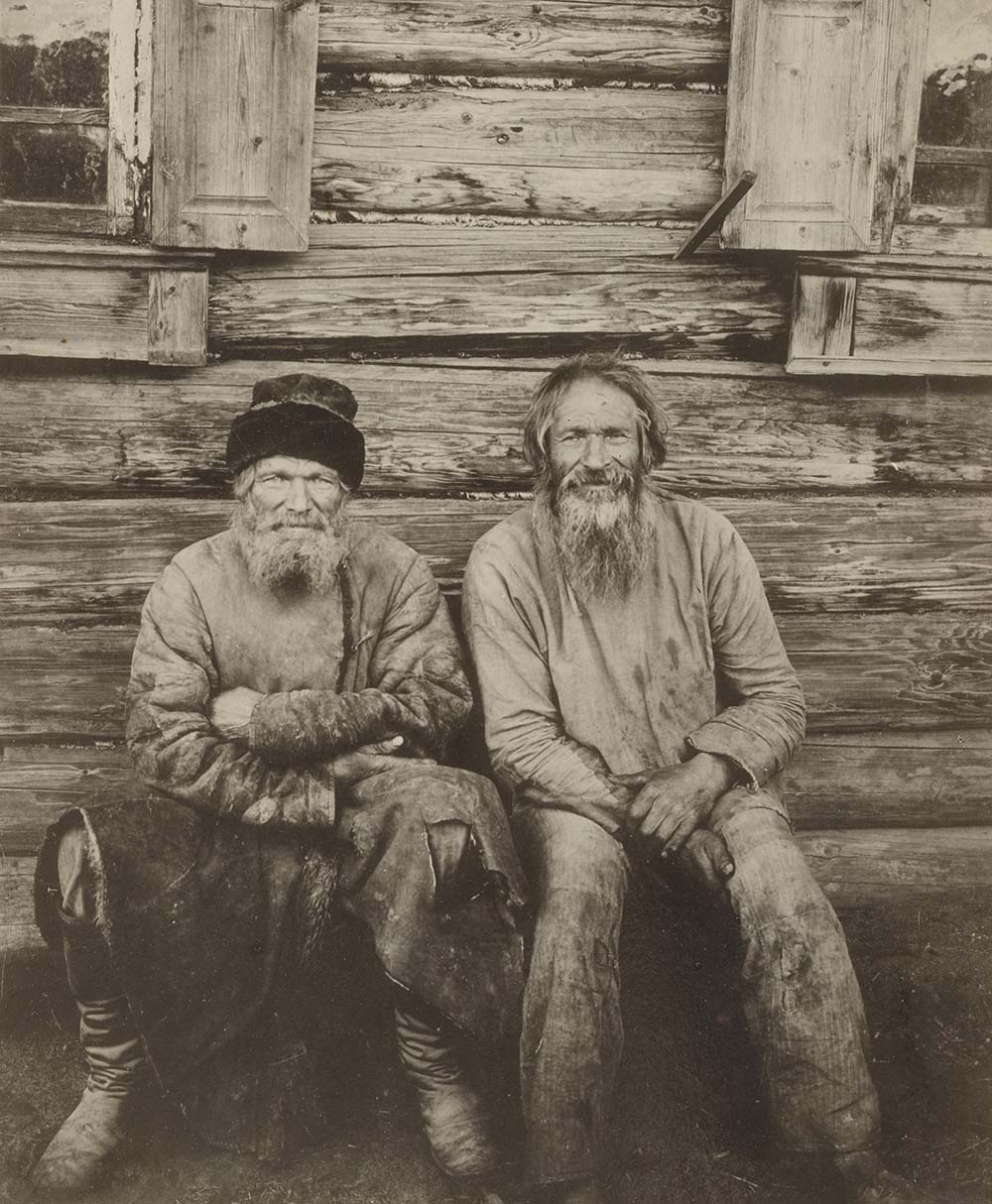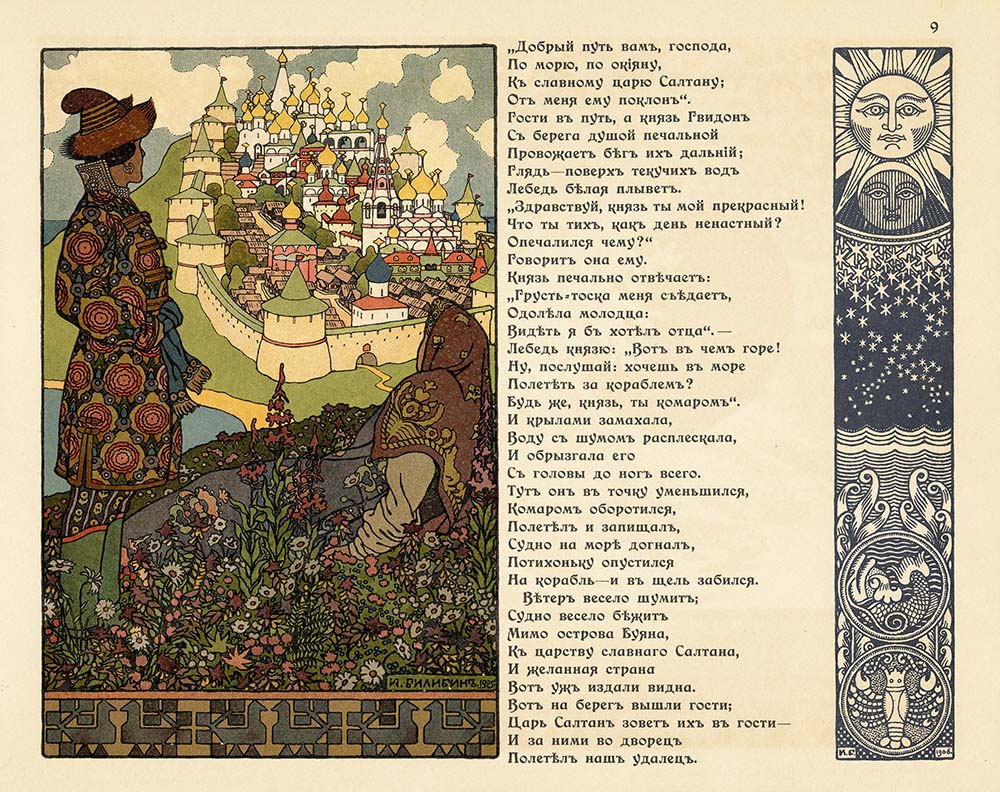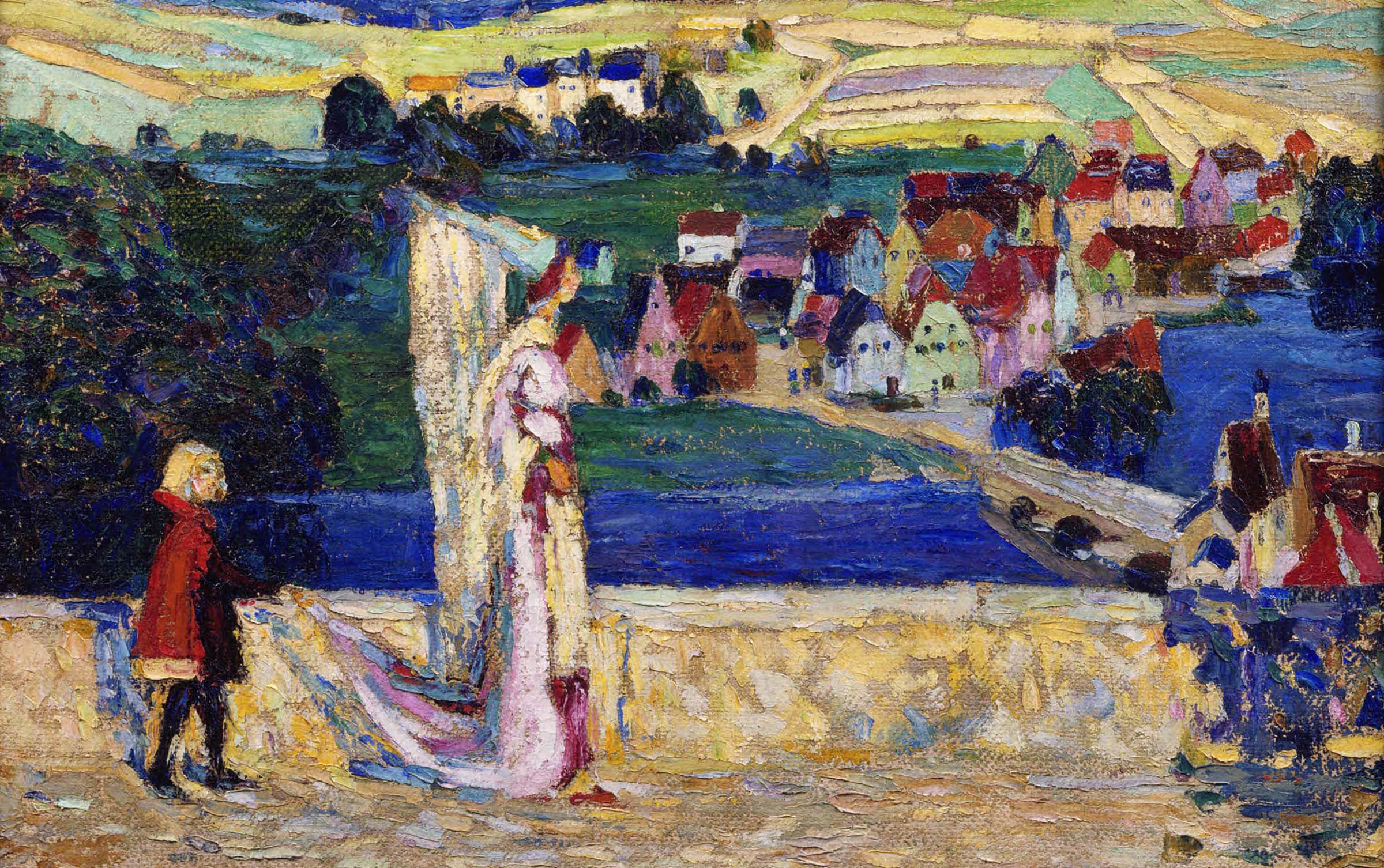Rudeness has consequences in fairy tales. Strangers met on the road may be more than they seem, so politeness is prudent. If a farmer is working his land and a passing old man asks what he’s sowing, he had better not answer, “I’m sowing cocks!” if he doesn’t want three-foot-tall phalluses sprouting in his field at harvest time.
This is the lesson of “A Crop of Cocks,” one of more than a hundred obscene folktales compiled by the nineteenth-century Russian ethnographer Aleksandr Afanasev. The farmer ends up selling some of his unexpected bounty—which can move on command—to a wealthy noblewoman, who uses them as proto-vibrators. Afanasev couldn’t find a home for his ribald narratives, but he did publish eight volumes of some six hundred family-friendly folktales between 1855 and 1863, establishing the standard versions of such stories as “Vasilisa the Beautiful” and “Maria Morevna,” whose popularity endures to this day.
Interest in folklore surged in nineteenth-century Europe, partly as a result of increasing nationalist sentiment across the continent, to which Russia was no exception. But even as educated readers clamored for more folk literature, and scholars worked to trace the genre’s origins and patterns, attempts to appropriate folk tales in the interest of national mythmaking inevitably foundered. Folklore proved both too strange and too universal to serve as a keystone of national culture. Nowhere is this more true than in the case of Afanasev and his bawdy tales.
Afanasyev’s contributions to folklore studies earned him comparison with the brothers Grimm, whose compendium of German tales, first published in 1812, established the standard to which later collectors aspired. The Grimms set out to showcase the richness, beauty, and authenticity of the German past. They were influenced by the Romantic nationalism of such thinkers as Johann Gottfried von Herder and Georg Wilhelm Friedrich Hegel, which encouraged many European intellectuals of the time to look to peasant society to find national cultures unsullied by modernity and cultural cross-pollination.
In Russia, the division between cosmopolitan elites and peasants—many of them serfs—was particularly acute. The country had not shared in the cultural and scientific flourishing of the Renaissance. In the early eighteenth century Peter the Great imposed reforms to modernize Russia’s institutions according to Western European models. One hundred years later, educated Russians were speaking French and dressing in tailcoats, but the vast majority of the population lived as their great-grandparents had.
The rise of nationalism—itself issuing from Europe—delivered a new imperative for the Russian elite to take stock of Russia’s status vis-à-vis the rest of the continent. One group, known as the Slavophiles, extolled the virtues of the country’s historical peasant culture and the Orthodox Church, and contended that Russia’s seat apart from Europe had given it a unique destiny. The Westernizers, on the other hand, wanted the nation to imitate further the political and social organization of its western neighbors.

One of the early prominent Slavophiles, Pyotr Kireevsky, was also an amateur folklorist. In the 1830s, with the encouragement of Aleksandr Pushkin—himself a great admirer, and sometimes plunderer, of Russian folklore—Kireevsky assembled a collection of folk songs, in part to refute the assertions of the Westernizer Pyotr Chaadayev that Russia’s popular traditions were inferior to Europe’s. (Chaadayev, who was declared legally insane as a punitive measure after publishing his writing, had particularly harsh views of Russian peasant culture; other Westernizers were enamored of it.)
“With each hour,” wrote Kireevsky in an 1833 letter to a friend, “I feel more strongly that the essential, distinguishing feature of barbarity is lack of memory; that there is no high deed, no harmonious word without a vivid feeling of one’s own dignity, that there is no feeling of one’s own dignity without national pride, and no national pride without national memory.” It is perhaps understandable that the tsarist government, under the reactionary Nicholas I—“a bland, philandering tsar, an ignoramus and a cad,” in Vladimir Nabokov’s succinct judgment—would suppress Chaadayev’s writings for disparaging Russian culture. But Kireevsky couldn’t get many of his songs published either, despite his seemingly patriotic motives. Censorship had tightened after the failed 1825 Decembrist revolt, when a group of revolutionaries attempted to seize power between the death of Tsar Alexander I and the accession of Nicholas I. Under the new regime, only select scholars, adhering in their commentaries to the official doctrine of “Orthodoxy, autocracy, nationalism,” were allowed to publish on folklore. This changed only after Nicholas’ death in 1855.
Afanasev published his first collection of tales that same year, at the age of twenty-eight. They were a hit, and for good reason: fantastically diverse, they are alternately sweet and uplifting, funny and surprising, enigmatic and dark. Some are about magic, talking animals, or young men who prove unexpectedly heroic, become rich, and marry princesses. Others feature malign creatures such as vampires or wood demons, or more mundane hardships like poverty and domestic abuse. Of the recurring characters, the most famous is the mysterious Baba Yaga, whose hut can walk on chicken feet and who sometimes helps, sometimes torments those who encounter her. Virtue is often rewarded, but just as often things go awry. In “The Daydreamer,” a poor peasant spots a hare under a bush and imagines how he will catch it and use the proceeds to buy a sow, which will give him piglets to sell, making him rich enough to marry, so that one day he will be able to instruct his future sons: “Vaska and Vanka! Don’t overwork your laborers; apparently you yourselves have never known poverty!” He gets so excited that he shouts these words aloud, and the startled hare runs away.

Except for the dozen or so that he gathered himself, Afanasev based most of the tales on transcriptions given to him by the Russian Geographical Society, which possessed a trove that various collectors had added to over the years. His contribution was not as a fieldworker, but as a fastidious researcher and talented storyteller. As a child he read through the library his grandfather had left behind in the city of Bobrov, where his father worked as a lawyer. In 1844 he went to study law in Moscow and began publishing scholarly articles with a liberal slant in prestigious journals. He graduated from university in 1848, the year that a wave of revolutionary activity spread across Europe, toppling governments and terrifying the tsar, who cracked down on political activism at home.
Afanasev, who was inclined to “moderate Westernism and restrained liberalism,” in the words of Soviet folklorist Yury Sokolov, was denied a professorial career by an unsympathetic conservative examiner. But in 1849 a friend got him a job as an archivist with the Ministry of Foreign Affairs, a post he would occupy for the next thirteen years, the period of his most productive scholarly work.
Two decades had passed since Chaadayev and Kireevsky first butted heads, but the debate between Westernizers and Slavophiles was as vehement as ever. Both sides agitated for the abolition of serfdom, but for different reasons. When Alexander II, successor to Nicholas I, implemented the reform in 1861, Westernizers saw it as a step toward a less feudal, more modern society, while Slavophiles hoped the serfs’ emancipation would help Russia return to its traditional Orthodox roots.
Intelligentsia of all stripes were eager to understand peasant culture, which everyone could agree was at least Russian (and maybe more Russian than that of the country’s Europeanized elite). Writing in 1851, the liberal thinker Alexander Herzen—an advocate for emancipation who edited an influential Russian journal from exile—addressed the issue of Russia’s identity in a Europe wracked by revolution: “The Russian question takes on enormous, terrifying dimensions; it is very worrying to all parties; but it seems to me that everyone is too caught up with the imperial Russia, the official Russia, and not enough with the Russia of the people, the voiceless Russia.” Afanasev’s collections of tales, reissued again and again to satisfy demand, were understood by many as representing the voice of the Russian people. Naturally, assessments of the tales diverged, with some readers praising them for their beauty and virtuous ideals, and others finding nothing but “unrestrained fantasy, full of exaggerations and crudity,” as one Westernist Russian critic put it.
Afanasev was likely motivated more by scholarly curiosity and a love of the material he was working with than by politics. When one of his books, a collection of popular legends about Christ and various saints, was banned on grounds of blasphemy—ironically, and predictably, causing its initial print run to sell out at once—he commented: “They simply can’t understand that there is a million times more morality in these folk stories than in sermons stuffed with rhetoric.” Still, he was aware of his work’s relevance to the intractable "Russian question," and he corresponded with Herzen following the latter’s flight from Russia, even paying him a visit in London in 1860.
In 1862 the police raided Afanasev’s house after learning of a meeting he had held with Vasily Kelsiyev, an émigré and friend of Herzen who had secretly returned to Russia intending to foment revolution against the tsar. The search turned up nothing compromising, but Afanasev’s connections with Herzen’s circle were enough to cost him his archival post. He had to work odd jobs for a while and sell off his library, and though he continued publishing on folklore, his time and energy for scholarly work were diminished. He died in 1871 at the age of forty-five, from tuberculosis, after years of destitution.

So might conclude the tragic story of Aleksandr Afanasev, who gave Russian folktales to Russian readers, were it not for a strange and fescennine coda. In the early 1870s, not long after his death, a publishing house in Geneva printed seventy-seven never-before-seen Russian folktales. Among them was “A Crop of Cocks,” along with dozens of other stories on such timeless themes as genitalia, defecation, bestiality, incest, and cuckoldry. Priests feature prominently, on occasion getting their testicles caught in traps. Noblewomen are also present: one instructs a lovelorn lackey to kneel down and “lick me like a dog.” In one story, a flea crawls up a woman’s orifice to spend the night, only to find itself chased around by “some kind of bald man.” In “The Soldier and the Priest” a wily soldier, lusting after a priest’s wife, tells him there’s been a decree requiring him to give all the priests in the area a good fucking. The holy father offers his wife instead but agrees to get into a cart with them and lie facedown beneath his wife while the deed is done. In the course of things, the priest becomes so aroused that his erection juts through a hole in the bottom of the cart, causing his daughter to gaze in wonder at what she takes to be the soldier’s extravagant endowment, lancing through both of her parents at once, “and the tip still dangling!”
These stories were fascinating to folklorists and lay readers alike, but for many years, the circumstances of their publication were as obscure as their content is forthright. Although the book was published in Switzerland, its preface was signed by an anonymous “Bibliophile” purporting to be a member of a brotherhood of Russian monks running a secret print operation “where no sacrilegious censor’s hand has yet penetrated.” This “Bibliophile” holds up the tales as examples of “genuine people’s speech, sparkling with all the brilliance and wit of the common man,” and, in grandiose style, takes his native land to task for its squeamishness and lack of press freedom. The transparency of this clerical facade may seem obvious to readers acquainted with “The Soldier and the Priest,” but it was enough to fool a committee of European folklorists in 1883, who lauded the imaginary monk for his commitment to “the greater glory of science.”
The title of the collection, Russkie zavetnye skazki (Russian Secret Tales), has also tripped up scholars. The word zavetny can mean secret or hidden, but also cherished, handed down, even sacred—a concatenation of meanings that embarrassed at least one translator who came across a reference to the text while unfamiliar with its contents. It may have been with some appreciation for this irony that Vladimir Dal, philologist and friend of Afanasev, first used zavetny to describe a collection of untoward folk sayings that he assembled in the 1850s. It was thanks to Dal that this multivalent term became the standard one applied by his contemporaries to folkloric texts unpublishable in Russia.
We know today, thanks to the work of various scholars committed to the greater glory of science, that Afanasev compiled these remarkably vulgar tales, which for obvious reasons he never tried to publish alongside his other collections. In the 1960s, Soviet folklorist Erna Pomerantseva unearthed reminiscences from the nineteenth-century philologist Fyodor Buslaev that credit Viktor Kasatkin, a political activist and associate of Afanasev, with bringing the stories to Europe. Kasatkin, who died in Switzerland in 1867 after being banned from Russia for revolutionary activity, likely left the tales in the care of friends living abroad. He also may have authored the sardonic preface. (It’s possible he edited and added to something Afanasev had already written.) Still, just how and why the tales came to be published in Geneva in the 1870s remains a mystery. The preface references plans to bring out further collections of zavetnye tales and sayings, but these never arrived, probably because Kasatkin and Afanasev had both been dead for several years by the time the book appeared.
Because Russian Secret Tales was published abroad and its content was so salacious, the book couldn’t figure in debates over national identity the same way Afanasev’s other collections did. Still, it’s tempting to read the stories as peculiarly Russian, perhaps even more so than their tamer cousins. They are as earthy and authentic as any oral literature—“genuine people’s speech,” as the “Bibliophile” puts it. Yet he situates the tales within a rogue’s gallery of obscene stories from other European nations, which he cites as evidence of these nations’ open-mindedness, and hence, their modernity. To this nineteenth-century Russian reader, getting in touch with the folksiest of folk storytelling was just another way of joining the European community, of keeping up with the Joneses. The Secret Tales’ first English translator, an anonymous enthusiast working from a French rendering, expressed astonishment at the text’s echoes of Boccaccio and French sources. He refused to speculate on these borrowings’ implications for “the serious scholar and the profound investigator of the Russian national character,” but one hardly needs to be an “ex cathedra savant,” as he puts it, to recognize that sexual and scatological jokes are as transnational as they come. The most extreme expressions of folk humor are those involving bodily processes we’re all familiar with.
The idea that folklore is a pure expression of national character now seems quaint. We understand much better how legends migrated from place to place, leading to similarities between different traditions. In Afanasev’s time, scholars like Buslaev and Alexander Veselovsky were already developing theories of how groups “borrowed” stories and characters from one another. (They were both converts from the Mythological school, to which Afanasev belonged, which taught that folklore originated in ancient myths about the natural world.) We are also, of course, much warier of making broad generalizations about people on the basis of national or ethnic identities. But the concept of national character still holds sway, as does the notion that we might grasp hold of it, if only fleetingly, in the form of some cultural artifact or other. It would be facile to claim that to be Russian means nothing more than “belonging to the Russian nation,” and we surely have a right to ask of Russian folktales (or books, or music, or movies) what they can tell us about Russianness.
What if they tell us many contradictory things at once? It’s possible to perceive a deep-seated resentment against the clergy and other authority figures in the Secret Tales. But, as the philologist Boris Uspensky has argued, the humiliations visited on fictional priests could also be seen as a funhouse reflection of the deference and respect they normally enjoyed among the people. Afanasev’s collections helped open educated Russians’ eyes to the richness of peasant culture, yet this richness also posed problems for those trying to define Russian identity. At the same time, the idea of Russianness as either lagging behind or usefully counteracting European culture has remained alluring.
The Bolsheviks saw Russian nationalism as an obstacle to building an international proletariat, and after Vladimir Lenin took power he promised a “war to the death on Great Russian chauvinism.” Nevertheless, within a few decades Joseph Stalin declared Russians to be “first among equals” in the USSR and credited the Russian people with being the primary reason for the defeat of Nazi Germany. A handful of the Secret Tales, the ones about priests stealing from peasants rather than buggering their wives, made their way into print, but the really indecent stories remained accessible only to scholars in the know. It wasn’t until the 1990s, after the fall of the USSR, that the Russian Secret Tales were finally published in Russia.
Folklore had long lost its place at the center of debates over national identity, but in the chaos that followed the collapse of the Soviet Union, the old questions about Russia’s place in the world were as contentious as ever. The wish to catch up with the West once more jostled with a sense of being separate, being Russian. Russianness could mean almost anything.
